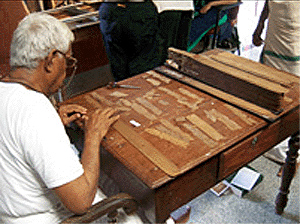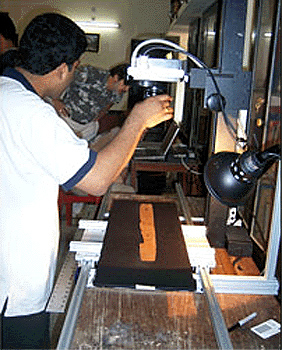Ancient Sanskrit Manuscript goes Digital
BY: MAHESH RAJA

The badly damaged leaves of the manuscript must first be organised
Nov 18, PUNE, INDIA (BBC) — Scientists from the US are using modern imaging techniques to digitally restore a rare 700-year-old Indian palm leaf manuscript on Hinduism by Sri Madhvacarya. Written by Harsh Kabra.
Restorers from New York's Rochester Institute of Technology (RIT) are working on Sarvamoola Grantha which expounds on the essence of Hindu philosophy, the meaning of life and the role of God. This priceless collection of 36 erudite commentaries was written in Sanskrit by Sri Madvacharya (1238-1317 AD), one of India's greatest theologians.
In addition to commentaries based on sacred Hindu scriptures such as the Vedas, Upanishads, Gita, Puranas, Brahma-sutras, Mahabharata and others, the collection also includes independent philosophical tracts, a commentary on daily rites, and several hymns in praise of God
Dr PR Mukund, a professor of electrical engineering at RIT, is leading the project along with his colleague Roger Easton.
"Among the various scholars and spiritual leaders in India during the last millennium, Sri Madvacharya had a profound impact on the society," explains Dr Mukund.
"He analysed all aspects of Hindu holy texts and showed the structure of the spiritual world that serves as a backbone of the world's diversities. As a result, preservation of this collection for future generations is essential," he says.
Deteriorating
These manuscripts were stored at Phalimaru Matha (a monastic establishment of the Hindu tradition) near the coastal town of Udupi in the southern Indian state of Karnataka. Dr Mukund has had a long association with several such mathas and has been actively involved in the publication of books on philosophy. He was unnerved by the deteriorating condition of the 13th century manuscripts.
"Over time, many of the original manuscripts were lost or were badly damaged due to deterioration of the palm leaves," he reveals.
Many leaves are cracked or have chipped off. Substantial parts of the leaves are missing in some collections. Friction between the binding cord and the edge of the hole on the palm leaves has further damaged them. Inappropriate storage has led to the palm leaves staining, splitting and sticking to each other. As a result, the manuscript is very brittle and difficult to handle without further damage.
"The palm leaves have darkened over time and are now dark brown in colour," adds Dr Mukund. This has made it difficult to read the manuscript with the naked eye.

Scientists acquiring images of the original palm leaves
Cutting edge
The project is making use of cutting-edge technology to digitally restore the manuscripts. Initially, high-resolution images of the manuscripts are acquired. Depending upon the size and format of the manuscript, each leaf can be captured in five or more sections. These sections are then connected to make an image of the complete palm leaf. After this, the images are processed to enhance the readability of the text.
The team is also preparing to use a novel long-term storage technique. For the first time, images of the palm leaves will be etched on the silicon wafers normally used in the microelectronic industry. Dr Mukund explains that silicon wafers can withstand very high temperatures and are not affected by the presence of water. It will also be possible to read these images without using additional equipment.
The team also plans to image some 800 more palm leaf manuscripts written since the time of Sri Madvacharya. However, all of this would need substantial funds.
"We need about $100,000 per year for the next three years," Dr Mukund says. "We have started the project, but have no money to pay staff and lab fees for silicon processing."
See the original Sun story from September 25, 2006: Restoration of 700-Year-Old Sri Madhvacarya Text.
